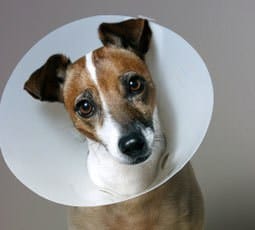CANINE LICK GRANULOMA
A lick granuloma is also referred to as an Acral Lick Granuloma. It is a self-inflicted circular skin lesion usually located on the lower third of the front or hind leg, just above the paw. The area involved is always one that the dog can reach by licking, which he or she does continuously and compulsively.
CAUSES
* The true underlying cause of lick granulomas remains unknown, although a combination of medical and psychological factors appears to be responsible. The lesions are thought to be associated with stress or boredom in some dogs and even to be an obsessive/compulsive disorder in others. The continuous licking helps these dogs pass the time.
* Psychological disorders such as Separation Anxiety, a new pet or child in the home, or a nearby animal invading the dog’s “territory” create anxiety and stress. These dogs relieve their stress by picking out new areas to focus on, then lick them for extended periods of time.
* Lick granulomas can also occur secondary to allergies. For example, allergic inhalant dermatitis results in inflamed, uncomfortable itchy skin which may trigger the dog to begin licking. In this case, appropriate treatment for the allergy usually resolves the problem. Allergy testing is a valid consideration in these cases.
* Lick granulomas can occur secondary to pain from an arthritic knee or ankle. Discomfort from an old fracture that healed poorly can also act as a stimulus for licking.
* A foreign body such as a thistle spine or splinter could provoke a reaction that draws the dog’s attention to that particular spot and elicits a licking response.
* Thyroid Disease resulting in low levels of thyroid hormone can be an underlying cause. Blood tests confirm low thyroid hormone levels and oral supplementation with thyroid hormone effectively resolves most lesions in these cases. Certain breeds are predisposed to Thyroid Disease .
* This type of foot-chewing may be compared to nail-biting in people. We chew our nails when we are bored or worried, out of habit, or even as an obsessive/compulsive behavior. Often, we find similar motivations in these foot-chewing dogs. Frequently, there has been a change at home such as:
o stress
o lengthy confinement
o addition of a new pet or human house guest to the family
o death or loss of a companion pet
o loss of owner or absence of a family member
o moving to a new home
o boredom
For many dogs, treating the skin lesion is not enough; the dog must be palliated psychologically as well. Extra attention to the pet on a reliable basis may be all that is needed; however, some dogs actually require psychoactive drugs.
TOXINS
* The most common source of accidental pet poisoning in California is SNAIL BAIT.
* ONIONS are TOXIC to DOGS and CATS (and horses).
* Raw sour dough (as in breadmaking) can have enough ethanol for a pet to be poisoned.
TREATMENT
* Elizabethan collar.
* Antibiotics for a minimum of three weeks.
* Reduce stress or depression.
* Amitriptyline – helpful in only 30% of dogs.
* Prozac – helpful for 50% of dogs that lick.
* Naltrexone taken for one month – helpful in 50-60% of cases. Licking usually stops for weeks to months.
* Acupuncture
* Cost for one month of treatment for a 50 pound dog = $210.00.
(NOTE: Clean lesions daily with iodine-based solutions, rinse well with water and pat dry. Blotting with alcohol helps dry out the lesion.)
WHAT YOU AND YOUR VET CAN DO
* Identify and treat the primary cause. Symptomatic treatments consist of topical antibiotic ointments, cortisone creams, and/or topical anesthetic preparations. Injections of Cortisone into these granulomas usually causes them to resolve but sooner or later most dogs start licking again.
* Dogs with psychological disorders may respond to simple changes in environment geared to reduce stress and prevent boredom. Anti-anxiety drugs like Prozac have been advocated and acupuncture is also an effective alternative in certain cases. Stress and anxiety management plus medical intervention is the best choice for most cases.
COMPLEMENTARY TREATMENTS
HERBAL REMEDIES
Apply a solution of plantain (Plantago major) to the lesion. Preparation involves adding the leaves of the plantain plant to one cup of water. Boil for five minutes then let stand for five minutes or until cool. Use cheesecloth to strain out the solution. Apply the solution topically twice a day or as needed.
HOMEOPATHIC REMEDIES
Arsenica album 30c helps reduce constant chewing and licking. Give one pellet every four hours for three treatments. Rescue Remedy, three drops, three to four times daily, given by mouth or added to the water bowl has a calming effect.
(NOTE: Kava Kava, Hops, Skullcap, Valerian Root, and Passion Flower reduce anxiety.)
